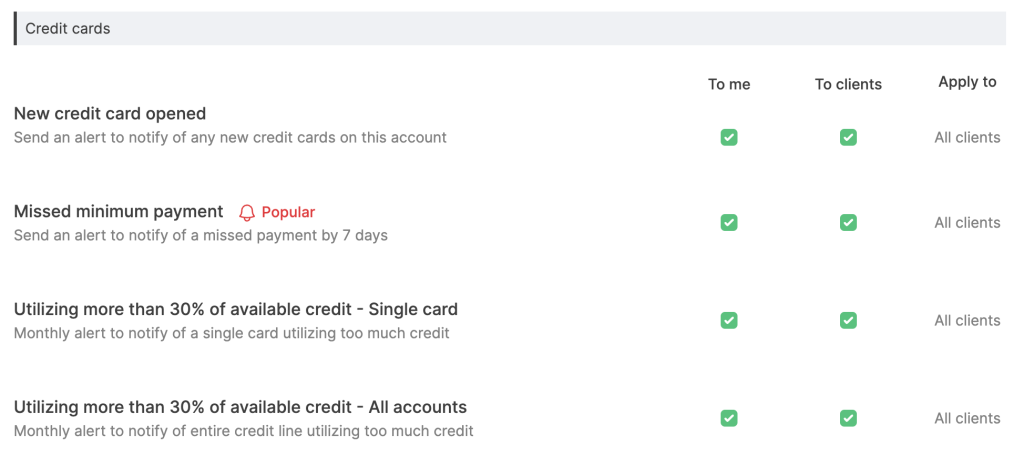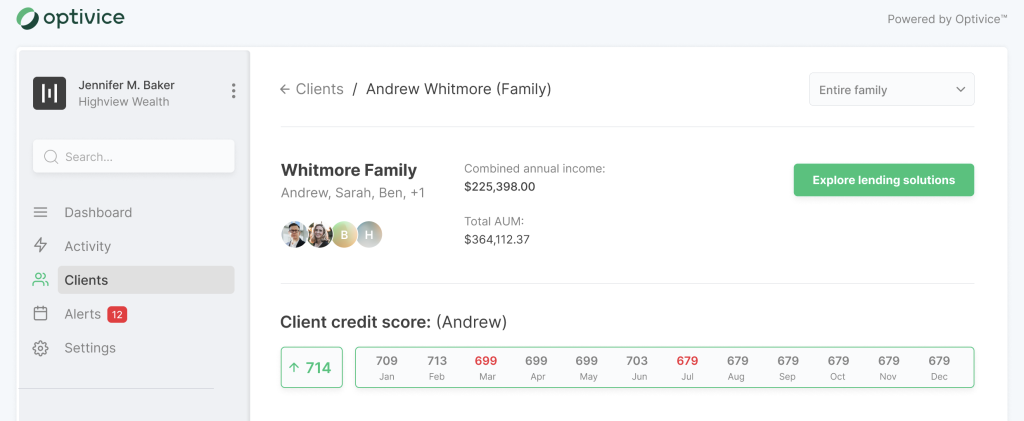Credit cards come in various types, each designed to cater to different financial needs and lifestyles. While one card might work great for one client, it may not be a good choice for another. Understanding the distinctions between these types can help you, as a financial advisor, provide tailored credit card advice to your clients.
When a client is opening a new credit card, help them by considering factors such as interest rates, fees, rewards, credit score impact, and security features, while aligning the choice with individual budgeting and spending habits. While each credit card will have its pros and cons that need to be considered, here’s an overview of the different types of credit cards available, the client they tend to be most ideal for, and their benefits:
Cash Back Credit Cards:
Key Feature: These cards offer a percentage of the amount spent as cash-back rewards.
Ideal for: Clients who want to earn rewards on everyday purchases without the complexity of points or miles.
Pros: Clients receive a portion of their spending back in cash, which can be used to offset future card balances or redeemed for other rewards.
Cons: Some cash-back cards may have higher interest rates, which can negate the value of cash-back rewards if you carry a balance.
Travel Rewards Credit Cards:
Key Feature: These cards earn points or miles for travel-related spending.
Ideal for: Frequent travelers or those who want to save on travel expenses.
Pros: Clients can accumulate points or miles that can be redeemed for airline tickets, hotel stays, car rentals, and other travel-related perks. Some cards also offer travel insurance and exclusive access to airport lounges.
Cons: Many travel reward cards come with annual fees, which can offset the value of rewards if not used frequently for travel. Some travel rewards may also have blackout dates, limited availability, or restrictions on booking, making it challenging to use rewards for desired travel.
Balance Transfer Credit Cards:
Key Feature: These cards offer a low or 0% introductory APR for balance transfers.
Ideal for: Clients with existing credit card debt seeking to consolidate and reduce interest payments.
Pros: Clients can transfer high-interest balances from other cards to the balance transfer card, potentially saving on interest and allowing them to pay off debt more efficiently.
Cons: Balance transfer cards often come with fees for transferring balances, reducing the potential savings from lower interest rates. The low or 0% APR introductory period is typically limited, and after it ends, the interest rate may increase significantly.
Secured Credit Cards:
Key Feature: Requires a security deposit, which serves as the credit limit.
Ideal for: Clients with limited or no credit history or those rebuilding their credit.
Pros: These cards help individuals establish or rebuild credit by reporting payment history to credit bureaus. They offer a stepping stone to unsecured credit cards.
Cons: Secured credit cards require a security deposit, which ties up funds that could be used elsewhere and may have limitations on how quickly credit limits can be increased, hindering credit growth.
Business Credit Cards
Key Feature: Designed specifically for business-related expenses.
Ideal for: Small business owners and entrepreneurs.
Pros: Clients can earn rewards tailored to business expenses, track business spending separately, and potentially build a business credit history. These cards often provide expense management tools and business-focused perks.
Cons: Some business credit cards may require the business owner to provide a personal guarantee, potentially putting personal assets at risk. Business credit card rewards programs can also be intricate, making it challenging to fully understand and optimize rewards.
Rewards Credit Cards (General)
Key Feature: Offers rewards points or miles for various types of spending.
Ideal for: Clients looking for versatile rewards and perks.
Pros: These cards provide flexibility in earning rewards across different spending categories, such as entertainment or gas, allowing clients to tailor their rewards based on their preferences.
Cons: These cards often come with higher interest rates, which can be costly if your client carries a balance and does not benefit fully from rewards. Some rewards cards have annual fees, which may outweigh the value of the rewards earned, particularly if usage is not substantial.
Low-Interest Credit Cards
Key Feature: Offers a lower ongoing APR compared to other cards.
Ideal for: Clients who carry a balance and want to minimize interest charges.
Benefits: Clients can save money on interest payments, making this type of card suitable for those who plan to carry a balance from month to month.
Cons: Low Interest credit cards typically have less attractive rewards and benefits compared to other credit cards. These cards also have stricter approval requirements, making it more challenging for individuals with lower credit scores to qualify.
Student Credit Cards
Key Feature: Designed for college students with limited credit history.
Ideal for: Students looking to establish credit while managing their finances.
Pros: These cards provide an opportunity for students to start building credit responsibly and often come with features that cater to student needs.
Cons: Student cards typically have lower credit limits, which may restrict purchasing power. In addition, students with limited credit history might face higher interest rates, making it important to pay balances in full.
Retail Store Credit Cards
Key Feature: Credit cards issued by specific stores and offer discounts, rewards, and financing options for purchases at those stores. They can only be used for purchases at that particular store or its affiliates.
Ideal for: Shoppers who frequently make purchases at a specific retail store and want to capitalize on the store’s rewards program or exclusive offers. These cards are also suitable for those looking to establish or rebuild credit through responsible use.
Pros: These cards often come with perks like discounts, special promotions, and rewards for shopping at the associated store. Some may offer exclusive access to sales events or early-bird discounts.
Cons: Retail cards often have higher interest rates compared to other credit cards, increasing the cost of carrying a balance and can only be used at specific retailers, limiting their usefulness for broader spending.
Premium Rewards Credit Cards
Key feature: Premium cards offer high-tier rewards, luxury benefits, and exclusive perks for clients with excellent credit.
Ideal for: Affluent clients who frequently travel, dine out, or engage in luxury experiences. Premium cards cater to those who can take full advantage of the extensive perks and rewards offered by the card, and who are comfortable with higher annual fees in exchange for top-tier benefits.
Pros: These cards often come with a range of exclusive perks, such as airport lounge access, travel credits, concierge services, travel insurance, elite status in hotel or airline loyalty programs, and high rewards earning potential.
Cons: Premium cards often come with significant annual fees, which may not be justified by the rewards and benefits for all users.
Charity Credit Cards
Key feature: Charity cards donate a percentage of cardholder spending to specific charitable organizations.
Ideal for: Individuals who are passionate about supporting specific charities or causes and want to make a positive impact while managing their finances. It’s also suitable for those who want to incorporate charitable giving into their financial routine.
Benefits: Client’s can contribute to their chosen charitable causes through everyday spending. Some cards also offer additional rewards or perks in line with the charitable theme.
Cons: The contribution to charity from these cards is often a small percentage of purchases, and cardholders may feel they could contribute more directly. Some charity cards may also have higher fees or interest rates, reducing the overall benefit to both the cardholder and the charity.
Understanding these different types of credit cards empowers you to guide your clients in selecting the best card that aligns with their financial goals and circumstances. Remember to consider factors such as spending habits, rewards preferences, credit history, and overall financial objectives when recommending a specific type of credit card to your clients.





















